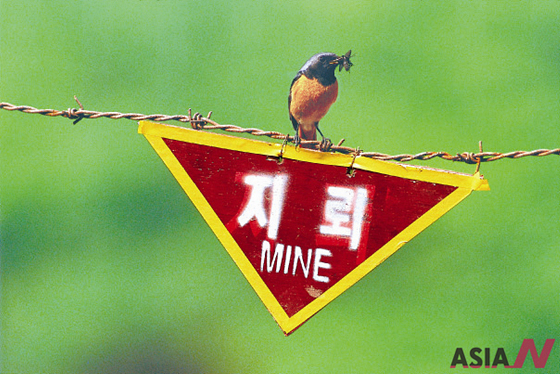DMZ: Land of Life and Hope
There are many places on earth where people cannot dwell in, but Korea has a unique piece of land where no man can live in. It’s not because of pollution or lack of drinkable water. It’s because it is a demilitarized zone, the product of the 21st century cold war, a place where no civilian is allowed to live in.
The tragic fratricidal war of the Korean peninsula started on June 25th, 1950.
It was a long war extended over a period of 3 years, 1 month and 2 days. With no winner or loser, only a high death toll and people’s livelihood turned into ashes, the Korean war concluded in a ceasefire agreement on July 27th, 1953 at the Panmunjeom. And with that, the DMZ, the demilitarized zone was born. No one imagined that Korea’s DMZ would last over half a century.The DMZ is a buffer zone where no army, weapon or military activity is allowed.
The demilitarized zone, where people used to form villages and live, became lost territory, ‘land abandoned by its own’, ‘land where no man can live’. Moreover, with the nation’s division, the north and south have competitively stationed heavy weapons on the borderlines of Korea’s DMZ. Thus, ironically, it has now become ‘the most heavily armed area’ in Korea.
The east-west cold war era, Korea’s demilitarized zone remains as the scene of history where ideologies conflicted.
Nevertheless, the DMZ which symbolized the nation’s division, the DMZ’s meaning is currently changing. From the place of the tragic fratricidal war, to the place for peaceful pilgrimage!
From communication severance to a forum for conversation. From a place of ruins to a place of prosperity. It is turning into a land of life and hope where past is reformed into the future.
The land where man’s interference was excluded for over half a century. It is becoming the land where life from the far past turns into overflowing hope. Especially, when considering it from nature’s perspective, Korea’s DMZ is receiving international attention for the unique opportunity to observe nature’s dynamic stability. Korea’s DMZ is the only place where one can observe how nature, destroyed by war, reconstructs itself once peoples’ traces are erased.
The demilitarized zone also is the vivid scene of dialectical paradox. The ground of fierce battle, shells were fired until the last leaf was destroyed, no animal could survive South and North Korea’s intense shootings. As the 4km long and 248km wide DMZ zone, an area where no man could enter, formed, nature poured its showers, seeds replanted themselves, wild animals reappeared and the DMZ zone slowly became a space where “only nature’s vitality exists”.
With its various geographical features, from Donghe to the western sea that’s shaped with mountains and plains, valleys and basin etc, the DMZ has slowly become a place where one can witness both southern and northern flora. A place where the south’s and north’s animals meet, a place of life where the south and north’s fish breed.
Although humans aren’t free to trespass, the DMZ has become a home for internationally protected species, not only endangered species, but for a myriad of natural treasures and plants that are on the brink of extinction.
It has especially become the last shelter for wild animals, which have been disappearing from our land due to industrialization and urbanization. One third of the 2900 or so plants that are growing in the Korean Peninsula. Half of the 70 types of mammals, and more than one fifth of the 320 types of birds have created life in the DMZ and are building their own version of paradise.
In the land that man abandoned, nature has carried peace and life for the past half-century.
On the land of DMZ that continues to hold our country’s pain, life that adapts to the rules of nature, with the changing of the seasons and without any interference, has first achieved unification of the sky, ground, sea and lakes.
The Kangwon Chulwon region of the DMZ is particularly receiving attention from internationally renown ornithologist as the sole wintering shelter for the endangered crane and the white-naped crane, which are both being protected worldwide.
Our nations’ crane, as the symbol of peace and longevity, are flying freely across the South and North borders, enjoying the first glimpse of unification.
Existing without evolving since its appearance 2million years ago, the DMZ is living proof of a so-called nature’s fossil.
This living cultural property, by cultivating life on the grounds of the DMZ for the past half-century, has achieved unification before our people.
A land that awaits tomorrow’s peace. The DMZ remains as the Korean peninsula’s future while also presenting the task of how man and nature can coexist. There is international assertion that the value of the wide array of living cultural property of the DMZ, the area that once symbolized our division, should be extended beyond our future as a unified Korean peninsula to being celebrated as a natural ecology cultural property.
Although South-North relations have met a halt since the Lee administration, the living cultural properties continue to return to the DMZ. They continue to teach us the everlasting, coexisting laws of mother nature.
The South and North need to unite resources to make the DMZ, the grounds that holds the fire of peace, into land where hope, harmony and coexistence overflows and where pain is overcome.
The DMZ, we all need to gather our heads in making the previous symbol of division into a forest where hope of unification can sprout. This is because the DMZ is the world’s natural heritage as well as nature’s gift and hope in times of a hostile past.
The year 2013 becomes the 60th year of the birth of Korea’s demilitarized zone. Shouldn’t we start preparing a proper 60th birthday banquet of peace and hope? For the DMZ that has offered our divided nation the unexpected present of nature by cultivating our horrendous battlefields into a forest abundant with life.




























































